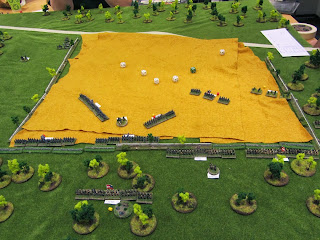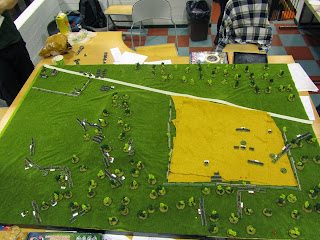Hi all,
Here's a report of the regimental level ACW game I hosted at Warcon using my 6mm collection. I'll also give you info on the scaling and the setup of things as I gather from the Google search traffic I'm getting on Hail Caesar that a lot of people are wondering on how to apply the Warlord Games rulesets to 6mm.
Scaling
Black Powder is a 28mm game and meant to be played on a huge table. The recommended depth of the table is something like five or six feet. The amount of figures needed in 28mm is something from 16-20 models per unit upwards and an army required by most of the sample scenarios would take hundreds of 28mm models. For someone with limited space and painting time this can be a dealbreaker.
As it happens, the game scales quite nicely to 6mm models when you simply halve all ranges. All the ranges used in the game are even numbers so there are no awkward half-inches to deal with. The effect on table space is not quite as drastic as with substituting inches with centimeters (
as I've done with Hail Caesar). This makes the standard 6x4 foot wargames table the equivalent of a 12x8 foot table. Lots of elbow room.
The standard frontage of an infantry unit in unmodified scale is about 240mm to 300mm. In half scale the same range is 120mm to 150mm. My ACW infantry is based on 25mm wide (
Fire and Fury) stands, and five of them gives me a nice looking unit 125mm wide and 50 models. For small units I use three stands just to keep the unit symmetric with the command stand in the middle. My artillery is based on 25mm stands too and I used two of them side by side for a battery of guns. Open order formations are simply represented by placing the stands one inch apart.
 |
| A Union brigade of one standard unit, two small units and a leader. |
The Scenario
I was determined not to return to Gettysburg for a while, but I spotted a nice and easy scenario in Wargames Illustrated 245. I needed a simple and straightforward scenario with simple terrain I could easily build in a convention 300 kilometers from my home. In WI245 there is a regimental Wheatfield scenario written by a David Brown for the Guns at Gettysburg rules (an ACW variant of General De Brigade). I adjusted the OOB to Black Powder and used the scenario map and the map from
Maps of Gettysburg to do my version. The reinforcement schedule worked quite well as it was without tinkering with which turn the units would arrive.
In the scenario, three Union brigades defend the wheatfield and the adjacent hill against an attack by three larger, veteran Confederate brigades. The Union forces will receive plenty of reinforcements but will they arrive too late to keep the Wheatfield in Union hands?
The Game
We had four players participating in the game. Two had read the rules but no-one had played the game before. I had played
Hail Caesar, which is quite similar, but this experience worked to my detriment a couple of times as a rule or a modifier would be subtly different and I would try and play the rule the wrong way. All the players had some experience from miniature wargames (and one was a fresh convert from the grim, dark future with no prior experience with historicals). I think we were pretty much at home with the ruleset by turn three so points to Black Powder for clarity and ease of learning!
One Union brigade was deployed on the Wheatfield in the center, one was protecting it's right flank on the hill and one was on Wheatfield lane ready to support the ones in the front. Two Union artillery batteries were also on the road.
The Confederates kicked off the game by marching on the table from the woods south of the Wheatfield. They had the veteran status but the Union forces facing them had a stone wall to take cover behind.
The reserve Union brigade saw an opportunity to threaten the Confederate left flank and marched on with great speed.
This forced the Confederates to deploy their reserve brigade to counter, and with a similarly good activation roll they now deployed into line withing musketry range of the Union brigade still in field column. Uh oh..
The volley of musketry caused some casualties in the Union column, and they hastily started to form line. One regiment was too disordered to comply, and had to remain in column. (Red markers are casualties, yellow markers are disorder)
At the Wheatfield the Confederates took their sweet time to reach the Union defenders (two consecutive failures in command checks, I think). When they charged, the Union forces protected by the stone wall had no trouble repulsing the attacker. On the Confederate right the skirmishers were pushed back but this was not enough to remedy the obvious blunder of charging headlong into a stone wall.
The hill objective received a charge as well. Freshly Raised troops versus Reliable veterans, so the result was clear? Nope, the Confederates were repulsed again.
To make things worse the Union forces took their opportunity to cut the Confederate line in two and capture their artillery while they were at it! The desperate Confederates on the right flank assumed a defensive posture.
On the Confederate left both parties were pretty beat up but the Confederates had failed to gain a breakthrough.
Even on the far Confederate right the regiment had trouble brushing aside the skirmishers in front. The noose was tightening on the right flank as three isolated Confederate regiments were slowly being encircled.
As all of the Confederate attacks had failed and Union reinforcements were flooding to the field we decided to call the game. The utter failure of the attacks owed a bit to hasty scenario conversion and to my own tactical blunders. Design-wise, I think there wasn't an appreciable difference between veteran troops and the green troops they were facing. The "drama" of the scenario would have had the initial Union defenders running and the real fight would have been fought between the reinforcements and the worn out Confederates. To make this the probable outcome I'll need to tinker with the stats a bit. I think as far as tactics go, I shouldn't have attacked that wall head on but rather flank the position as I had room and time to do so.
The Black Powder rules felt nice and light. The troops were easy to maneuver and there were just a few modifiers to learn. I think the ruleset works best for a carefree saturday evening game where you don't want to stress out on the minutiae and just want to have a lot happen on the table with not much effort. I think I have to look at the skirmisher rules again though as one small skirmisher unit held a full close order regiment in melee for three turns I think. Was that just good luck for the boys in blue?
Anyway, it was a great evening and I had the pleasure to play with three gentlemen I haven't played with before, one of whom will hopefully be a new convert to historical wargames!












































